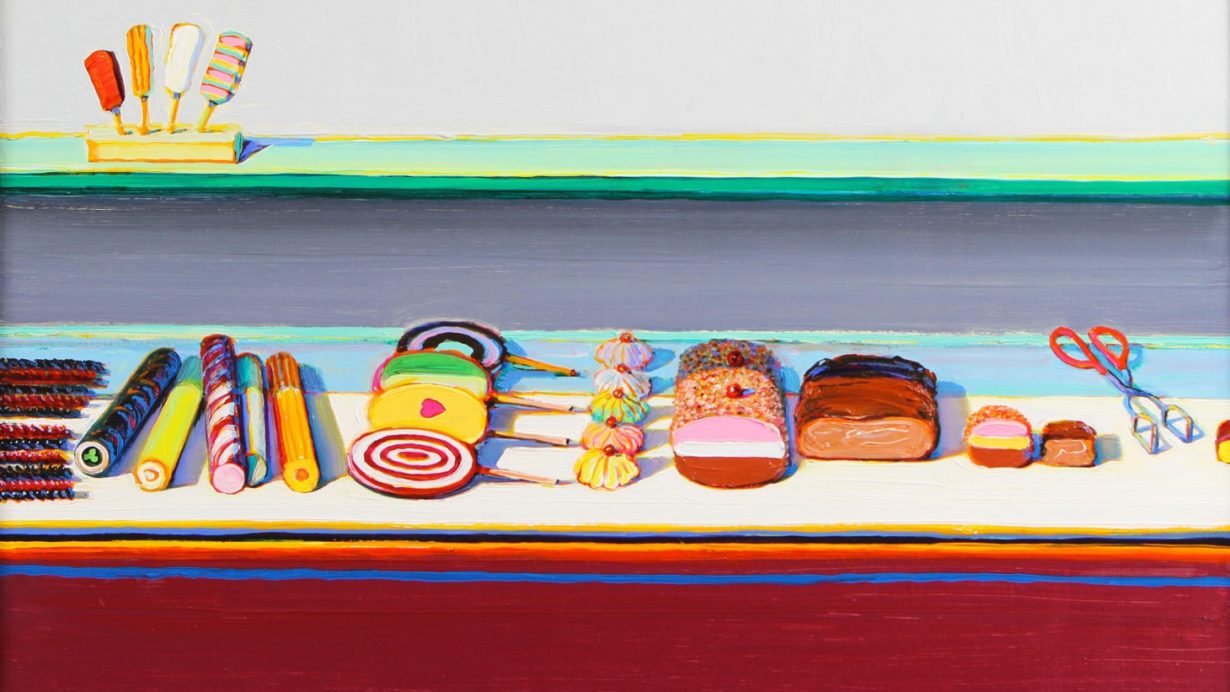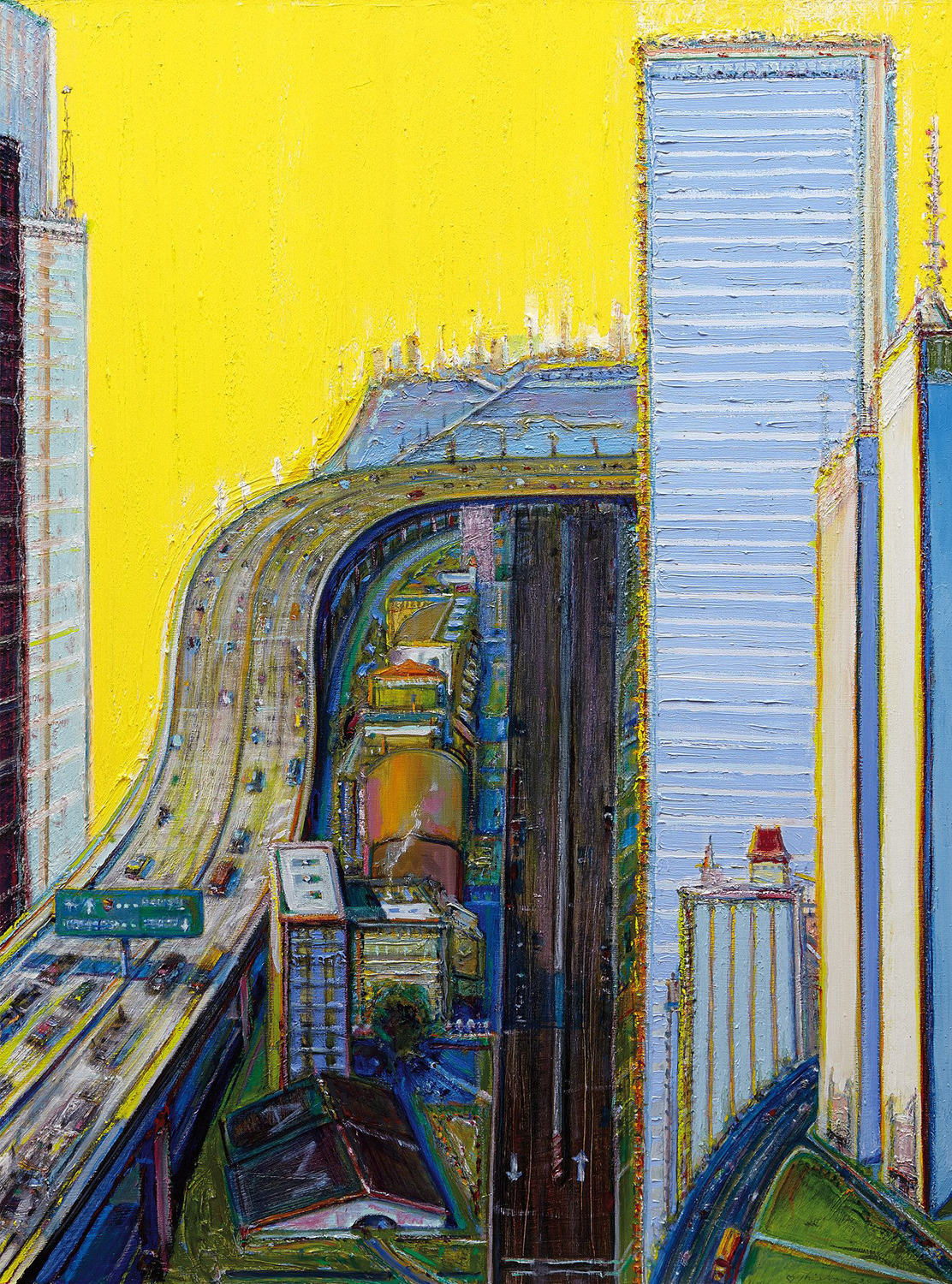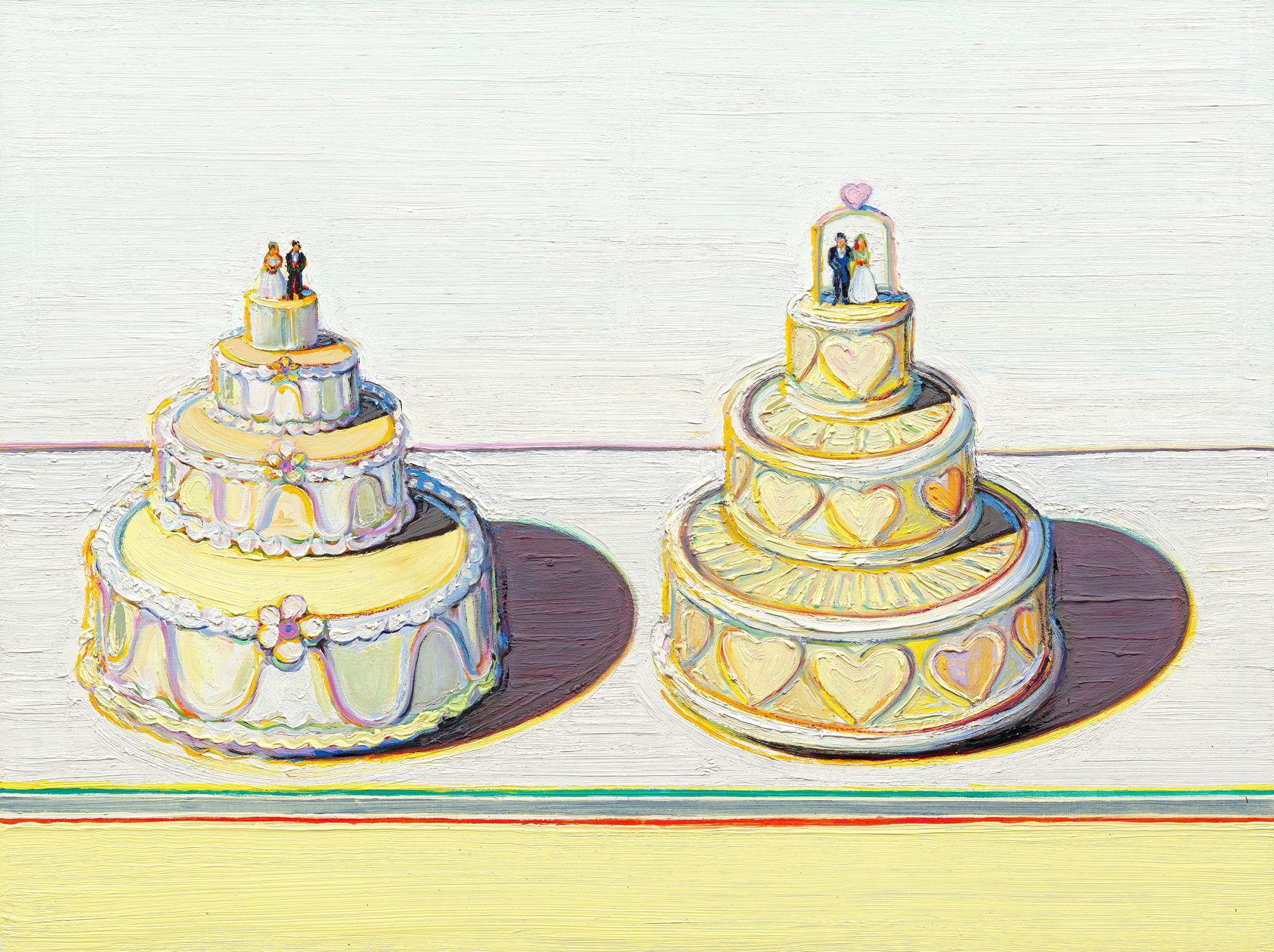‘His paintings seem to hold all of his sad and happy days together at once. There was a magic, an old-fashioned alignment between art and life that is hard to describe.’ Following the death of Wayne Thiebaud (1920-2021), we look back to Ed Schad’s feature from the May 2016 issue of ArtReview, which finds art history, historical circumstance, an excess of confectionery and the history of one man’s life in the extra-believable artworks of one of the most significant painters of the postwar American Dream (often in its most saccharine incarnations). “The irony is that my painted cakes are quite awful things. Too much fake meringue, too much frosting,” Thiebaud confides in Schad. “Americans are astoundingly gross in their pies and cakes. It is an irony that people think of them as pretty.”
After visiting with Wayne Thiebaud in his studio, a one-storey metal building about a kilometre from the California State Capitol, I seized upon his painting from 1969 called Peking Ducks in Thiebaud’s recent Rizzoli monograph. The artist had directed me to it, saying that “a great number of things [in the book] haven’t been seen before”, and I had never seen Peking Ducks.
During the visit, Thiebaud told me about his relationship with Willem de Kooning. In 1956, Thiebaud took a year off from teaching at Sacramento City College, to “move to New York to try and meet my heroes”, he said. He had the good fortune of not only meeting and striking up a friendship with de Kooning but with Franz Kline as well.
Thiebaud thought of de Kooning not as a person committed to a particular vision of painting, or someone beholden to some theory of what art should be (as were many of his peers). Instead, Thiebaud’s de Kooning is not a very good modernist at all. De Kooning was intent on telling the young painter that he needed to decide for himself how he wanted to see, that Thiebaud needed to avoid all of the trappings of given styles and what people thought was art, and just find out, essentially, what he cared about.
De Kooning himself, Thiebaud remembered, was split between the inspirations that actually drove his art and what writers believed drove his art. “‘People talk about me being influenced by Picasso,’” Thiebaud recalled de Kooning saying at the time, “‘but my big hero is Soutine.’”

Peking Ducks could be an emblem of this exchange between de Kooning and Thiebaud. Large, Soutine-like carcasses hang from wires against a blank background, but that background is a de Kooning just getting started. Creamy washes of pinks and reds collect like tributes to the older painter. A solitary shaded vertical stripe is enough to give the painting the most miniscule amount of pictorial depth.
I cannot say for sure that the painting is about de Kooning, but it offers a glimpse into Thiebaud’s world. Peking Ducks is de Kooning, an immigrant’s shop in Southern California, a statement on painting and Thiebaud’s transfigured memory all at once. The work is full of historical circumstances converging and being transfigured. We’ve seen it before, but not like this.
At ninety-five, Thiebaud not only still paints but also plays tennis three times a week, a passion that he has held his entire life. A longtime and dedicated teacher, his study is full of artwork by former students, along with assorted bits of treasure from Peru, Mexico and former lives. The artist walks a bit slowly these days, but he has a gentle, inviting manner that is immediately apparent. He is easy to talk to and sprinkles his stories with the names of people one would have loved to meet. “Stella has a pretty good topspin forehand,” Thiebaud said. “You would have loved Kline. A sweet man, he would sell little drawings in Washington Square.”
Thiebaud seems to treasure his life, and the manner of his conversational style – interrupting personal stories with accounts of the speed of Berthe Morisot’s brush or the genuinely strange quality of Francisco de Zurbarán’s fruit – can serve as a fair account of his paintings. He can present an accurate survey of chic New York painting on the backs of arcade games that he remembered from his childhood, as in Four Pinball Machines (1962), or he can empathise with Van Gogh’s peasant farmers in a painting of shoes that were probably his own (Black Shoes, 1963). The more you look, the more you see art-historical underpinnings lingering below the surface of his bright Americana.

Thiebaud’s work has long been associated with Pop art and the economic miracle that was the US after the Second World War (no Pop monograph lacks one of his paintings). Yet it would be better to think of Thiebaud, as does Adam Gopnik in the artist’s 2000 retrospective catalogue, as the son of Jean-Baptiste-Siméon Chardin and the Great Depression.
Thiebaud took de Kooning’s words to heart. Instead of engaging with the legacy of Cézanne, building his images with masses of twitchy strokes (“What art was supposed to look like,” according to Thiebaud), he began letting memories of working in restaurants or in the fairs of Long Beach take over the abstract shapes of his preliminary compositions. Triangles became pies, circles became cakes and rectangles became long lines of sandwiches, cut in half and accented with olives on toothpicks.
“I hung some ties up,” Thiebaud said, “but mostly I worked from memory, of going into Kress department store and seeing those candy counters. This was during the Depression so you didn’t have a lot of means by which you got these objects. Quite amazing how beautiful displays were made in order to entice people.”
In 1972, Thiebaud bought a house in the Potrero Hill district of San Francisco. The move produced over a decade of cityscapes that have been associated with those by Richard Diebenkorn and Robert Bechtle. He then moved to a farmhouse south of Sacramento, where the farmlands of the river delta became another decade of landscapes. Each and every locale of his life appears in his paintings.
The cityscapes and the river scenes, as Thiebaud discusses them, are products of an inner reality. The locations, as in the fantastic Apartment Hill (1980), which belongs to the Nelson-Atkins Museum in Kansas City, only exist in the mind: “You feel that district of San Francisco, with its hills and buildings,” Thiebaud says, “and it really gives you a sense of vertigo.”

The association between Thiebaud and Pop persists, however. The Dallas Museum of Art’s 2015 survey International Pop, for example, found his Salads, Sandwiches, and Desserts (1962) next to Icelandic artist Erró’s Foodscape (1964). The paintings make an odd couple. Erró’s work, constructed from labels and pictures that the artist gathered on a trip to the United States, is a cornucopia multiplied, an exaggerated look at the American Dream through an outsider’s eyes. Each bit of food is accurately rendered and labelled, a mountain of plenty turned into a vertiginous horror. Salad, Sandwiches, and Desserts, on the other hand, is not believable; or, perhaps more accurately, it is extra-believable. Its rows of sundaes and sandwiches certainly seem ordinary, only they are a little too vibrant, a little too orderly. The icing on the cakes is a little too plump. “The irony is that my painted cakes are quite awful things. Too much fake meringue, too much frosting,” Thiebaud said. “Americans are astoundingly gross in their pies and cakes. It is an irony that people think of them as pretty.”
The day before I met Thiebaud, his wife of 56 years, Betty Jean Thiebaud, passed away after a long battle with Alzheimer’s. The news was not yet public and Thiebaud didn’t tell me at the time. Betty Jean was a familiar face in his paintings, a frequent sitter for his long portraits, as in Two Kneeling Figures (1966). Thiebaud kept this information to himself and was more than generous with his time. Though it must have been a very hard day, Thiebaud seemed to have found a good way to live in his art and painting, a rarity in the farflung and often overheated artworld of today. He was happy to talk of his painting, which was another way of talking about his life, and so of Betty Jean.
As I was leaving, Thiebaud was off to his easel to begin again, taking up his memories and the subjects he had painted his entire life. His paintings seem to hold all of his sad and happy days together at once. There was a magic, an old-fashioned alignment between art and life that is hard to describe.
But then, speaking of Chardin, Thiebaud does it justice: “The wonderful thing about common objects, of almost any kind, is exactly what the poets talk about. They are talking about a transcendent potential, that they can be more than they are. For instance, let’s say a bunch of kitchen objects like Chardin: copper pipes, clay pots, a loaf of bread. Your job as a painter is to make them different enough and special enough that when you go back to look at the kitchen’s actual objects, they seem wanting.”
This article was first published in the May 2016 issue of ArtReview.
